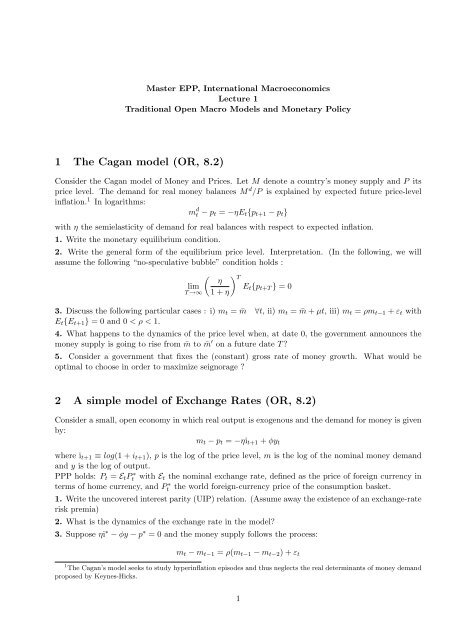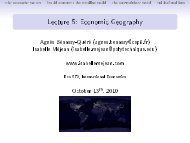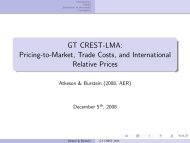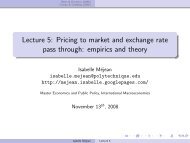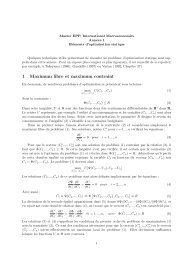Exercises - Isabelle MEJEAN's home page
Exercises - Isabelle MEJEAN's home page
Exercises - Isabelle MEJEAN's home page
Create successful ePaper yourself
Turn your PDF publications into a flip-book with our unique Google optimized e-Paper software.
Master EPP, International Macroeconomics<br />
Lecture 1<br />
Traditional Open Macro Models and Monetary Policy<br />
1 The Cagan model (OR, 8.2)<br />
Consider the Cagan model of Money and Prices. Let M denote a country’s money supply and P its<br />
price level. The demand for real money balances M d /P is explained by expected future price-level<br />
inflation. 1 In logarithms:<br />
m d t − p t = −ηE t {p t+1 − p t }<br />
with η the semielasticity of demand for real balances with respect to expected inflation.<br />
1. Write the monetary equilibrium condition.<br />
2. Write the general form of the equilibrium price level. Interpretation. (In the following, we will<br />
assume the following “no-speculative bubble” condition holds :<br />
( ) η T<br />
lim<br />
E t {p t+T } = 0<br />
T →∞ 1 + η<br />
3. Discuss the following particular cases : i) m t = ¯m ∀t, ii) m t = ¯m + µt, iii) m t = ρm t−1 + ε t with<br />
E t {E t+1 } = 0 and 0 < ρ < 1.<br />
4. What happens to the dynamics of the price level when, at date 0, the government announces the<br />
money supply is going to rise from ¯m to ¯m ′ on a future date T ?<br />
5. Consider a government that fixes the (constant) gross rate of money growth. What would be<br />
optimal to choose in order to maximize seignorage ?<br />
2 A simple model of Exchange Rates (OR, 8.2)<br />
Consider a small, open economy in which real output is exogenous and the demand for money is given<br />
by:<br />
m t − p t = −ηi t+1 + φy t<br />
where i t+1 ≡ log(1 + i t+1 ), p is the log of the price level, m is the log of the nominal money demand<br />
and y is the log of output.<br />
PPP holds: P t = E t Pt<br />
∗ with E t the nominal exchange rate, defined as the price of foreign currency in<br />
terms of <strong>home</strong> currency, and Pt<br />
∗ the world foreign-currency price of the consumption basket.<br />
1. Write the uncovered interest parity (UIP) relation. (Assume away the existence of an exchange-rate<br />
risk premia)<br />
2. What is the dynamics of the exchange rate in the model?<br />
3. Suppose ηi ∗ − φy − p ∗ = 0 and the money supply follows the process:<br />
m t − m t−1 = ρ(m t−1 − m t−2 ) + ε t<br />
1 The Cagan’s model seeks to study hyperinflation episodes and thus neglects the real determinants of money demand<br />
proposed by Keynes-Hicks.<br />
1
where ε is a serially uncorrelated mean-zero shock such that E t−1 {ε t } = 0. Write the dynamics of the<br />
exchange rate.<br />
4. Assume now that the government wishes to fix the (log of the) nominal exchange rate permanently<br />
at ē. What path of the money supply is consistent with having e t = ē permanently?<br />
4. During the beginning of the US Reagan administration in 1981, some US officials seriously discussed<br />
the possibility of making a transition to a fixed exchange rate for the dollar. However, they argued<br />
that it would be presumptuous for government officials to decide the best exchange rate and that they<br />
should instead let the market decide. The policy they proposed was to announce today that at some<br />
future date T they would permanently fix the exchange rate (using monetary policy) at whatever level<br />
prevailed in the market at time T − 1. Is this a coherent policy?<br />
3 The Mundell-Fleming-Dornbusch model (OR, 9.2)<br />
Consider a small open economy facing an exogenous world (foreign-currency) interest rate i ∗ . With<br />
open capital markets and perfect foresight, uncovered interest parity holds. Only domestic residents<br />
holds the domestic money, according to the following relationship:<br />
m t − p t = φy t − ηi t+1 (1)<br />
where m t , p t and y t respectively denote the log of nominal money demand, the price level and output<br />
and i t+1 = log(1 + i t+1 ). The Purchasing Power Parity needs not hold so that the real exchange rate<br />
q t = e t + p ∗ t − p t can vary. (In the following, the foreign price p ∗ is assumed constant.)<br />
The Dornbusch model effectively aggregates all domestic output as a single composite commodity and<br />
assumes that aggregate demand for <strong>home</strong>-country output, y d , is equal to:<br />
y d t = ȳ + δ(q t − ¯q), δ > 0 (2)<br />
where ȳ is the “natural” rate of output and ¯q the “equilibrium” real exchange rate consistent with<br />
full-employment. For simplicity, ȳ and ¯q are assumed to be constant.<br />
Prices are rigid in the short-run and flexible in the long-run. Namely, p t is assumed to be predetermined<br />
so that unanticipated shocks can lead to excess demand or supply. In the Keynesian<br />
tradition, it is assumed that output is demand determined. The price level adjusts according to the<br />
inflation-expectations-augmented Phillips curve:<br />
p t+1 − p t = ψ(y d t − ȳ) + (˜p t+1 − ˜p t ) (3)<br />
where ˜p t ≡ e t + p ∗ t − ¯q t is the price level that would prevail if the output market cleared.<br />
In the following, it is assumed that ψδ < 1 which assures a monotonic adjustment of the real exchange<br />
rate. To simplify, the following normalizations are also assumed: p ∗ = ȳ = i ∗ = 0.<br />
1. Interpret the assumption δ > 0 in equation (??).<br />
2. Interpret equation (??).<br />
3. Assume that money supply is constant (m t = ¯m). What is the the dynamics of the nominal and<br />
real exchange rates?<br />
4. What is the impact of an unanticipated permanent rise in the money demand at date 0?<br />
5. Consider now the same model with ȳ ≠ 0. Discuss and show graphically (and partially analytically)<br />
the short- and long-run effects of a rise in natural output.<br />
2


